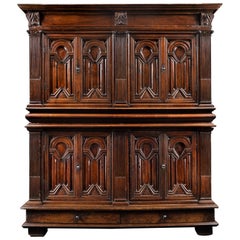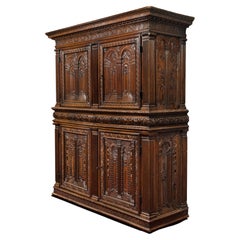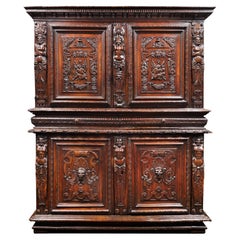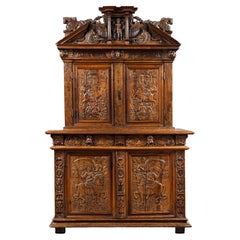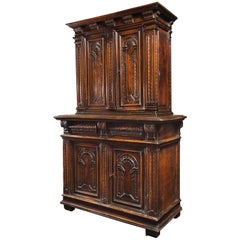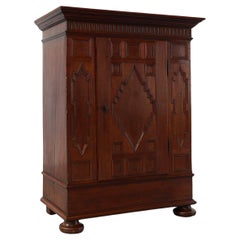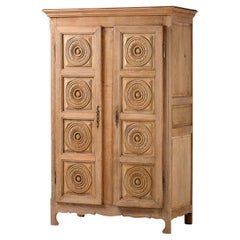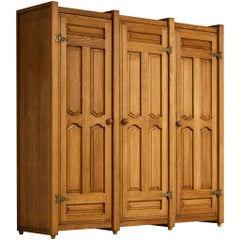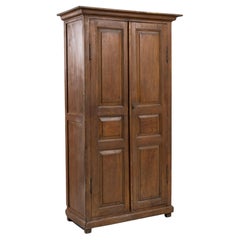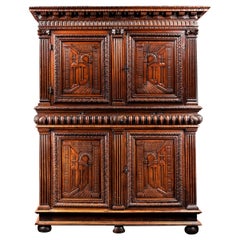16th Century Wardrobes and Armoires
to
Height
to
Width
to
Depth
to
6
6
292
464
890
399
170
483
166
28
9
38
76
49
125
87
103
25
7
6
5
1
6
4
1
6
6
6
Period: 16th Century
Renaissance Palace Wardrobe with Perspectival Views
Located in Saint-Ouen, FR
A rare carved walnut wardrobe opening with four door-leaves and two drawers in the lower part. The doors bear architectural views in low reliefs, fluted pilasters and Ionic capitals.
Upper Body
Two door-leaves with carved architectural perspectives open the wardrobe framed by three fluted pilasters with Ionic capitals.
Each door-leaf depict two semi-circular arcades whose cornice and base shows a central vanishing point. Likewise the pavement’s lines act for the artisan as a way to create depth. The vaulting instead leads us to think the vanishing point has to be situated where the handle is, between the two complementaries reliefs.
The elegant moulded belt hides an internal secret space, accessible through a moveable plank in the upper body.
Lower Body
Two door-leaves identical to those of the upper body framed by three fluted pilasters with Doric capitals. The base of the wardrobe opens with two large drawers.
The sides also bear panels depicting architectural perspectives. The external pilasters share their Ionic capital with the facade’s pilasters. Thus we can observe on the wardrobe’s sides the capital’s lateral parts with the elegant volute specific to the Ionic order.
This palace wardrobe is topped by an overlapping cornice standing on three consoles for the facade and two consoles on each sides. Placed right above the pilasters each console are adorned by fully expanded leaves.
During the 15th century a major interest for architecture and perspective studies arises and influences patrons tastes. The work of great theorists such as Leon Battista Alberti...
Category
Italian Renaissance Antique 16th Century Wardrobes and Armoires
Materials
Walnut
Important Renaissance Cabinet from Lyon 'France' with a Decor of Perspectives
Located in Saint-Ouen, FR
As soon as 1540 France's second Renaissance is in the making, intimately linked to the rediscovery of the Antique world. The development of the printing and engraving industry allows the spread of artworks and models in many cities and countries. The Italian influence can be perceived in every artistic field. While the French king entrust the most talented Italian artists with major projects such as Il Rosso or Primaticcio in Fontainebleau, French artists also travel to Italy to form themselves to this new style. In Italy they get acquainted with the work of Leo Battista Alberti the first to theorize perspective (De Pictura, 1435-36) and architecture (De re oedificatoria, 1541). Those two publications would have a revolutionary impact on arts.
Furniture is marked by the work of the most famous Italian architects of the time as well as French architects. Indeed Philibert de l'Orme competes with Alberti and by the end of his life publishes several treaties including one devoted to a theory of architecture (1567). Unfortunately he would not live to complete the second volume. In this treaty he expresses his interest for mathematical norms applied to architecture, copied from the Antique. His journeys in Italy allowed him to accumulate the most sophisticated references. Jean Bullant, another architect of great talent also theorizes his practice. He establishes rules characterizing Greco-Roman art staying faithful to Vitruvius.
Following this new inspiration the structure of furniture evolves. From then on appear columns, capitals, cornices, friezes and architraves. The ornamentation uses this inspiration as well with egg-and-dart, palm leaf and rose adorning the most beautiful pieces.
In Lyon, crossroad where meet merchants from everywhere those new experiments are welcomed. Lyon florishing printing industry allows the spreading of models and treaties essential to the artist's work. Thus the first publication of Vitruvius' De Architectura in France would be printed in Lyon in 1532.
Artists from Lyon rediscover and familiarize themselves with the Antique knowledge very early. They adopt those new ideas and use them in their own creations. Lyon cabinet-makers re interpret Antique architecture and Italian Renaissance palaces to give their pieces a pure and harmonious architectural structure. Grooved pilasters are particularly favored. They are topped by capitals of diverse orders always respecting the sequencing with simpler ones for the lower levels and the richest ones on the higher levels. As for the ornamentation, one of the great distinctiveness of Lyon workshops remains the architectural perspective illusions, drawing inspiration from Tuscany.
True masterpiece of the Second French Renaissance this important cabinet illustrates Lyon workshops' taste for fine Italian architecture inspired by Antiquity. An architectural perspective of great quality is treated in symmetry on each panel.
This two-bodied cabinet without recess stands on four rectangular feet. The base comprises a molding, a palm leaf frieze and is bordered by a braid.
The lower body is divided by three grooved pilasters with Tuscan capitals framing two door-leaves. The two panels are encircled by a moudled frame with palm leaves. They are finely carved with a decor of fantasized architecture depicting an Italian Renaissance palace erected symmetrically on each side of a grooved pilaster. On the ground floor a door opens through a stilted arch while the stories are opened with mullioned windows, dormers and occuli. Two large pegged-boss cladded pillars support the entablature enriched by a palm leaf frieze upon which stands an arch whose coffered intrados is centred by a rose. Behind this arch a pyramid appears, standing in front of a second facade with a window topped by a broken curvilinear pediment under a cul-de-four with a shell.
The checker flooring gives depth to the low-reliefs creating vanishing points structuring the panels and guiding the eye of the observer.
A thin laurel braid highlights the belt of the cabinet where are located two drawers. Their facades are adorned by palm leaves in hoops.
The upper body is encircled with palm leaves. The same ternary division as in the lower body appears. However, the pilasters are topped by Ionic capitals with volutes and egg-and-dart. The door-leaves are framed with flowers. On the panels the artist has designed another architectural decor. On the foreground open two arches on top of grooved pilasters with rectangular capitals adorned with palm leaves. The arches are enriched with braids and the coffered intrados bears a decor of roses. The spandrels also bear a flower decor. In the background another arcature hosts a fluted grooved column topped with double basket acanthus capital, characteristic of Corinthian order. The triangular pediment is interrupted by a choux bourguignon.
A large cornice crowns the cabinet. It stands on pilasters and forms an entablature comprising a palm leaf frieze and an egg-and-dart, triglyph and palm leaf cornice.
The cabinet's sides have also been carefully considered. The lower body's panels are enriched with an arch rising above a broken pediment portico hosting a twisted column. Flowers garnish the spandrels. An architectural facade completes the decor. The upper body's panels present two arches supported by a facade opened with dormers and mullioned windows as well as cartouches (one bears the inscription 1580 dating the cabinet) suggesting the interior of an Italian Renaissance palace, confirmed by the chandeliers. The flooring leads our gaze to a second arch with a broken curvilinear pediment where stands a flower vase. This arch opens onto a perspective of another facade along a road.
Inside the cabinet, on the lower body door-leaves appear two designs. On the right door is depicted a Crucifixion. Saint Mary and Saint John flank the Christ on the cross. In the bottom part is inscribed « Dure uiator abis nihil haec spectacula curas / Pendenti cum sis unica cura Deo. / Tota suo moriente dolet natura Magistro. / Nil qui solus eras caussa dolenda doles. ». The signature [Christoff Swartz Monachiensis pinx[it] / Ioa[nnes] Sadeler sculp[it]] tells us it was made by Johan Sadeler I (1550-1600) after Christoph Schwartz (1548-1592). This engraving belongs to an ensemble depicting the Passion of Christ Johan Sadeler executed in 1589 after an altar piece painted by Christoph Schwartz for the private chapel of Renée of Loraine, wife of Duke William V of Bavaria. This altar piece made of nine copper panels has been destroyed during the 19th century. The Crucifixion panel once in the centre of the altar piece is the only one that survived and is today kept in Munich's Alte Pinakothek.
On the left door appears Saint Francis receiving the stigmata. The inscription says : « Signastidomine Servum Tuum. Franciscum. Signis Redemptionis Nostrae ».
This Renaissance cabinet with an architectural decor appearing as much in the structure faithful to Antique rules...
Category
European Renaissance Antique 16th Century Wardrobes and Armoires
Materials
Walnut
French Renaissance Armoire
Located in Saint-Ouen, FR
Original lock and key
This piece of furniture shows no recess on its upper part. It opens with four folding-doors and two drawers within the belt. The key bears the date 1524 above cross motifs.
Burgundy and Lyon regions subordinated themselves to architecture in a different manner than the other french schools. Rather than using particularly columns and pediments pieces of furniture from Lyon borrow architecture’s organization principles and rigorous designs.
On the upper body a strong feeling of balance and symmetry appears with the folding doors reliefs. Swags of flowers and fruits held with knot cloth centered by a man seating on his arms. Here profiles, masks and chou de Bourgogne mingle with the structuring scrolls. The two lateral terms wear draperies and the goddess Diana in the center wears a belt of fruits similar to Hugue Sambin’s designs (Termes de Diane et de Venus, 1554, BNF).
The two palm-leaves enriched drawers and the alternating scrolls belt balance the weight of the cornice with its alternatings consoles and tops.
The lower body is also adorned by three terms with a feminine one in the center, all three are wearing fruits on their heads. The folding doors are centered upon a motif of cut cuirs by a mask in high relief. Wearing a feathered tiara...
Category
French Renaissance Antique 16th Century Wardrobes and Armoires
Materials
Walnut
$95,851
16th Century Cabinet with Knights Carving from Avignon Workshops 'France'
Located in Saint-Ouen, FR
Collection Jean Thuile
Around the mid-sixteenth century French furnishing evolves in its conception and ornamentation. The start of major archi...
Category
French Renaissance Antique 16th Century Wardrobes and Armoires
Materials
Walnut
French Renaissance Cabinet with Perspectives
Located in Saint-Ouen, FR
This Renaissance Cabinet reveals the great mastery of the Lyon workshops which are at the origin of its realization. Sculptors and wood-carvers worked here in symbiosis to express an...
Category
French Renaissance Antique 16th Century Wardrobes and Armoires
Materials
Walnut
French 16th Century Antique oak hand carved wardrobe
Located in Meulebeke, BE
France / 16th century / wardrobe / oak / Antique / Rustic
Wooden one door cabinet in oak with nice graphic carvings. This wardrobe has a foldable hanging system and is resting on fo...
Category
French Rustic Antique 16th Century Wardrobes and Armoires
Materials
Oak
Related Items
Hand-Carved Oak Armoire, France, 1950s
Located in Kaštel Sućurac, Splitsko-dalmatinska županija
Armoire in Carved Oak with Rosette Panels, France, 1950s
A stately presence marked by repetition and relief, this French armoire composes its façade in a series of rhythmic medallio...
Category
French Mid-Century Modern 16th Century Wardrobes and Armoires
Materials
Oak
Guillerme & Chambron Wardrobe in Solid Oak
Located in Waalwijk, NL
Guillerme & Chambron for Votre Maison, armoire or wardrobe, oak, brass, France, 1960s
This charming wardrobe is a good example of excellent woodworking by virtue of the graphical de...
Category
French Mid-Century Modern Vintage 16th Century Wardrobes and Armoires
Materials
Brass
Antique French 18th Century Provincial Carved Cherry Wood Armoire Wardrobe 1780
Located in Portland, OR
A good antique late 18th century carved French Provincial cherry wood armoire, circa 1780.
The armoire having a ogee stepped cornice (the cornice is removable), below is a shell shaped carving and a pair of carved doors, with panels carved in relief, the doors are fitted with the original hand forged steel lock escutcheons & door length steel barrel hinges, a key is present and the lock works with ease. The interior has two adjustable shelves and can easily receive a hanging rail, which Bloomsbury can install at no extra cost in our professional workshops if requested.
The armoire is raised on short cabriole legs with scrolled feet joined by a shaped skirt with a corresponding shell shaped carving, condition is very good, this very handsome late 1700s French armoire...
Category
French French Provincial Antique 16th Century Wardrobes and Armoires
Materials
Cherry
$4,495
H 84.5 in W 47.25 in D 29 in
Antique 19th C. French Louis XV Walnut Carved 3 Door Mirrored Wardrobe Armoire
Located in Dayton, OH
A beautiful antique 19th Century French Knockdown Armoire / Wardrobe. Features a walnut frame with three large beveled glass mirrored doors The cabinet opens to a large central are...
Category
Louis XV Antique 16th Century Wardrobes and Armoires
Materials
Mirror, Walnut
$3,600 Sale Price
20% Off
H 105.5 in W 78 in D 23 in
ANTIQUE JACOBEAN REVIVAL HAND CARVED ARMOIRE WARDROBE WiTH GREY FRENCH PAINT
Located in West Sussex, Pulborough
Royal House Antiques
Royal House Antiques is delighted to offer for sale this stunning, original circa 1840-1860 Jacobean Revival hand painted French Armoire...
Category
French Jacobean Antique 16th Century Wardrobes and Armoires
Materials
Wood
$6,508
H 73.63 in W 54.14 in D 19.3 in
French Limed Oak Armoire
Located in Antwerp, BE
Limed oak two door armoire.
Height 210 cm.
Width 127 cm.
Depth 64 cm.
Category
French Mid-Century Modern 16th Century Wardrobes and Armoires
Materials
Glass, Wood, Oak
1900s French White Wooden Armoire
Located in High Point, NC
A white wooden cabinet from France, circa 1900. This handcrafted armoire stands on turned feet, guarded by a golden-brass lock. A refreshing space maker and a stylish storage. Adorne...
Category
French French Provincial Antique 16th Century Wardrobes and Armoires
Materials
Brass
Armoire, Bleached Oak, France, circa 1940
Located in Kaštel Sućurac, Splitsko-dalmatinska županija
Armoire, Bleached Oak, France, circa 1940
Echoing the Sculptural Language of French Provincial Modernism
Sculptural in stance and restrained in detail, this tall French cabinet fro...
Category
French French Provincial Vintage 16th Century Wardrobes and Armoires
Materials
Oak
French parquetry Cabinet Armoire by Jules Leleu
By Jules Leleu
Located in Atlanta, GA
A large cabinet with parquetry design by Jules Leleu Paris, Model no. 4178. Designed in 1951 and this example is dated to 1953. Functioning as an Armoire for wardrobe, the cabinet fe...
Category
French Mid-Century Modern Vintage 16th Century Wardrobes and Armoires
Materials
Bronze
18th Century French Louis XV Walnut Carved Wardrobe or Armoire
Located in Casale Monferrato, IT
Rare and important antique wardrobe in solid walnut made in the late 18th century French Louis XV.
Characteristic wavy line with wood carvings on the floral taste front. Beautiful c...
Category
French Louis XV Antique 16th Century Wardrobes and Armoires
Materials
Walnut
$3,594
H 100.01 in W 61.42 in D 25.6 in
Tall Brutalist Wardrobe by Lane
Located in Brooklyn, NY
Tall wardrobe with brutalist mosaic motif by Lane Furniture. Designed for their Pueblo collection, featuring both cabinet and drawer storage.
Please...
Category
Mid-Century Modern 16th Century Wardrobes and Armoires
Materials
Walnut
French Louis Philippe Armoire, c. 1850
Located in Chicago, IL
This elegant French armoire dates to the mid-19th century, crafted in the Louis Philippe style with streamlined form and luminous, warm brown maple veneer. The well-proportioned cabi...
Category
French Louis Philippe Antique 16th Century Wardrobes and Armoires
Materials
Brass
Previously Available Items
16th Century Portuguese Wooden Cabinet
Located in High Point, NC
Handsome and dignified, this antique Provincial cabinet combines understated simplicity with a beautiful auburn finish. Made in Portugal in the 16th century, paneled doors unlock wit...
Category
Portuguese Country Antique 16th Century Wardrobes and Armoires
Materials
Wood
16th Century French Renaissance Cabinet with Perspective Carving
Located in Saint-Ouen, FR
Original lock and keys
Good state of conservation
Upper part
The two folding doors are spectacular with their architectural view, civil fantasy with the central pilaster a...
Category
French Renaissance Antique 16th Century Wardrobes and Armoires
Materials
Walnut
Rare Early 16th Century Naïve Cabinet from Béarn or Côte-basque, 'France'
Located in Saint-Ouen, FR
Opening with foor door-leaves this cabinet is an exceptional example of regional furniture. Its building is rather simple while the decor is particularly rich and carefully executed....
Category
French Gothic Antique 16th Century Wardrobes and Armoires
Materials
Wood
H 67.33 in W 50.4 in D 16.93 in
Rare Period Italian Renaissance Walnut Wood Armadio Bookcase
Located in Dallas, TX
This important and very large walnut wood case piece is an Italian Armadio that dates to the 16th century (with later boards in areas. See condition). ...
Category
Italian Renaissance Antique 16th Century Wardrobes and Armoires
Materials
Walnut, Pine
16th Century French Gothic Armoire
Located in Rochester, NY
French antique Gothic armoire, Finely carved quarter sawn white oak. Two doors over one large drawer. Interior fitted with shelves. Original han...
Category
French Gothic Antique 16th Century Wardrobes and Armoires
Materials
Oak, Wood
Recently Viewed
View AllMore Ways To Browse
Tiger Oak Bedroom
Antique Elm Wardrobe
Armored Jewelry Armoire
Compactum Wardrobe
English Mahogany Wardrobe
4 Door French Armoire
Burr Walnut Armoire
Campaign Style Wardrobe
Cream Armoire
English Oak Wardrobe
French Armoire With Bun Feet
Oak Single Armoire
1700s French Armoire
Antique Pine Armoire Cupboard
Armoire Wardrobe Compactum
Birds Eye Maple Wardrobe
Chinese Armoire Red
Door Handles Bauhaus
